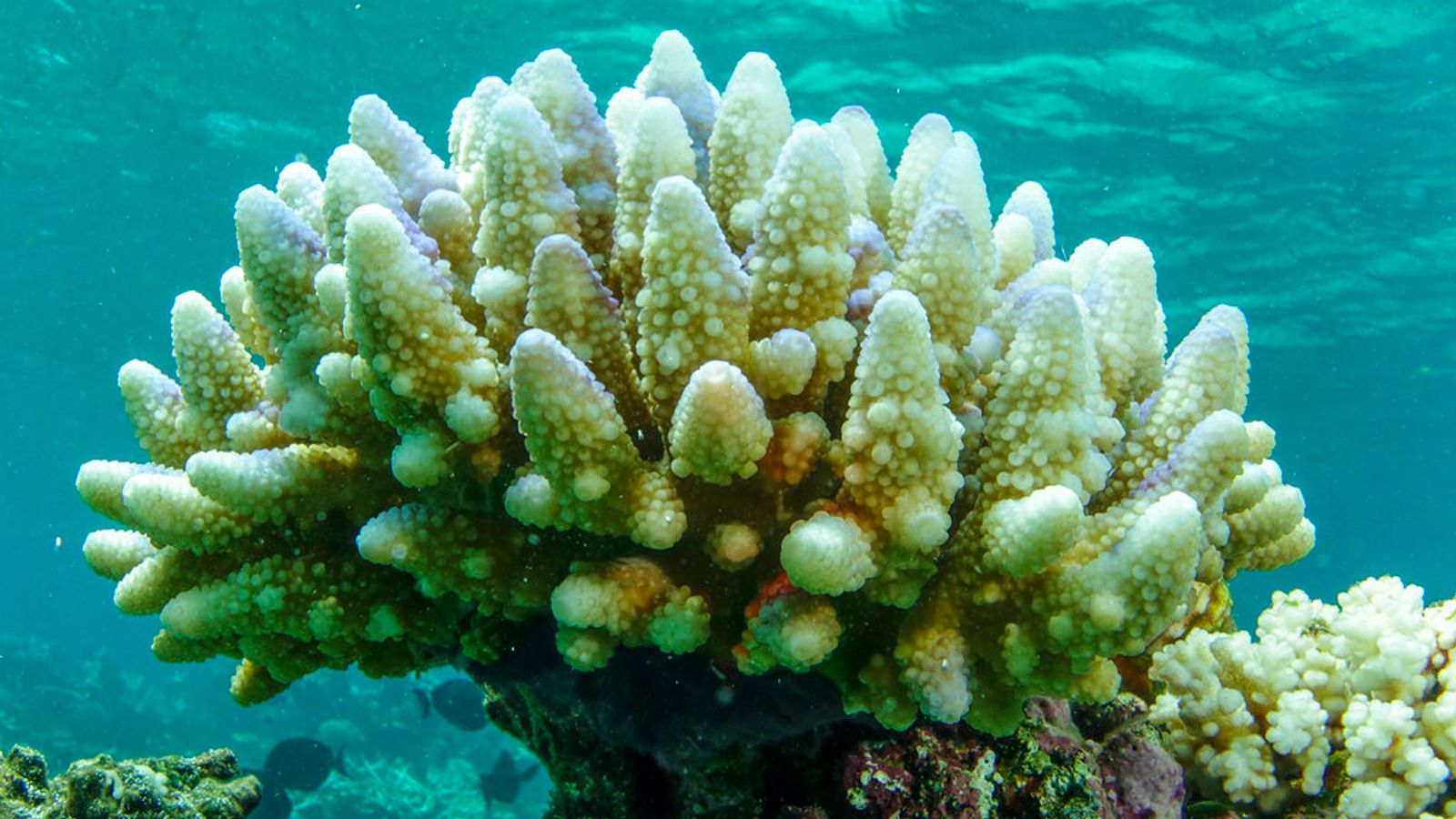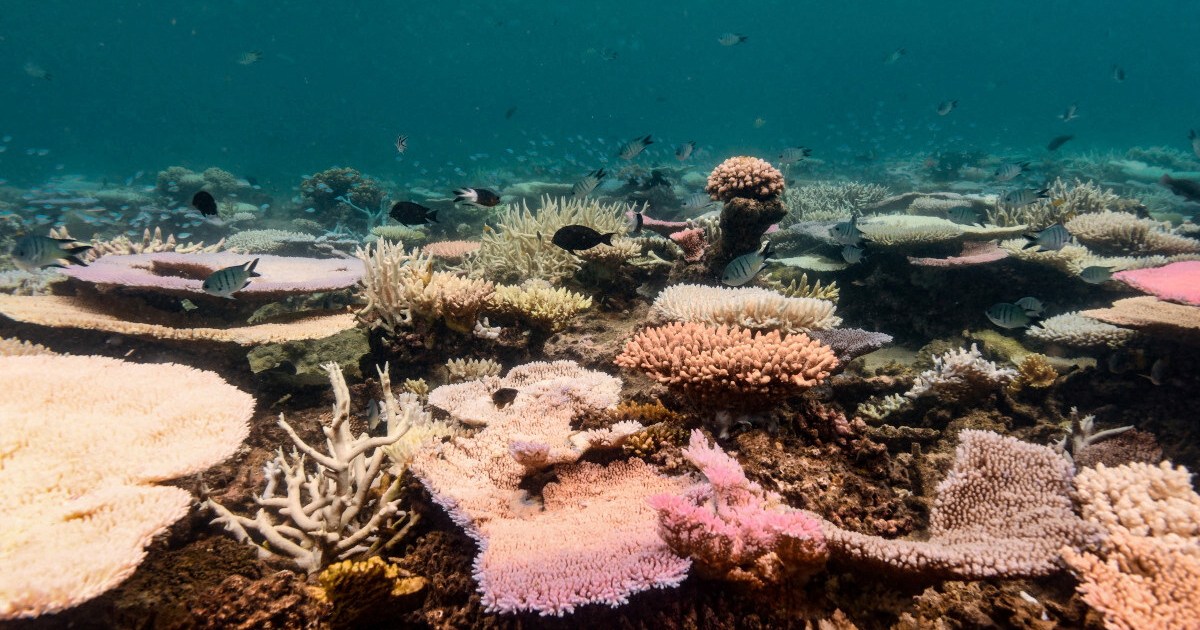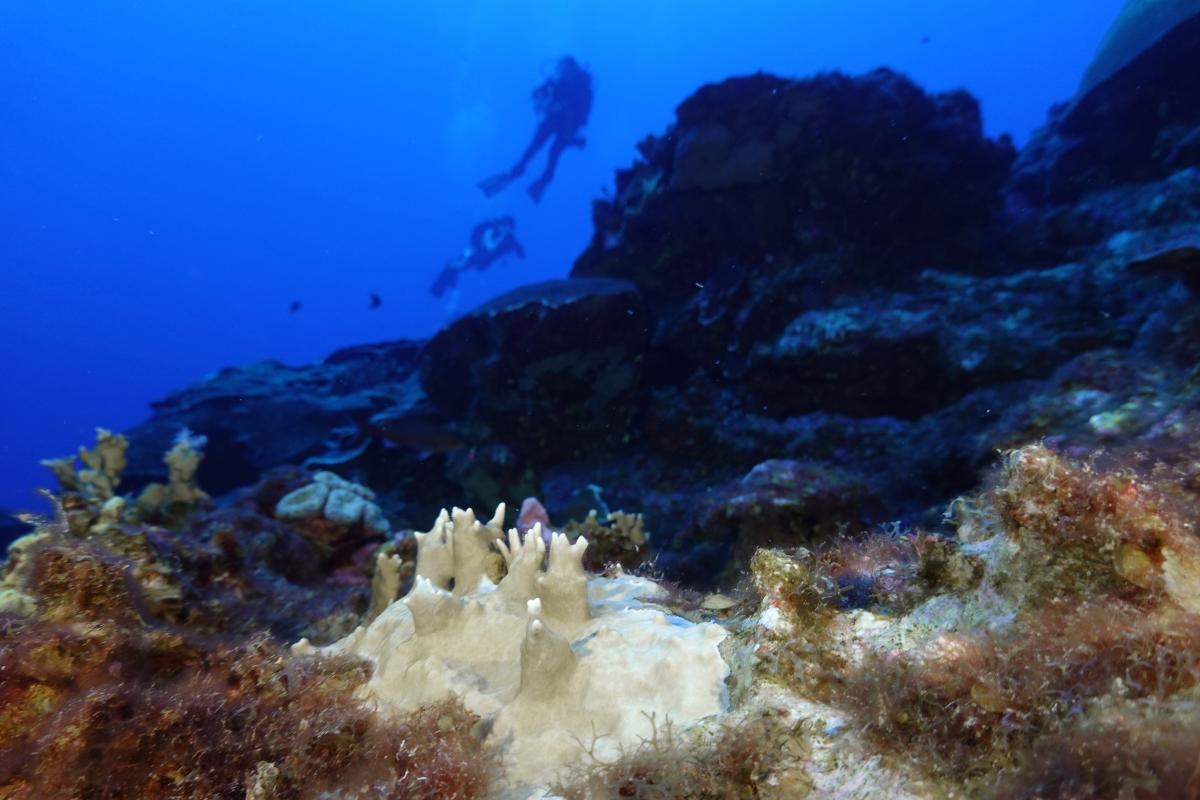
Coral reefs are experiencing a global bleaching event in at least 53 countries, triggered by warming oceans and climate change. The National Oceanic and Atmospheric Administration and International Coral Reef Initiative describe bleaching as coral expelling algae when stressed, leading to potential death. The event, caused by ocean heating from climate change and El Nino, reached record high sea surface temperatures in March 2023. Bleaching occurs when waters are 1C warmer for four weeks, impacting ecosystem health, biodiversity, erosion prevention, and local economies reliant on coral reefs.

The Great Barrier Reef, the world's largest coral reef, is experiencing its seventh mass bleaching event as a result of soaring ocean temperatures attributed to the global climate crisis and exacerbated by El Nino. This event marks the fifth occurrence in just eight years, threatening the reef's diverse marine life and economic importance to Australia. Coral bleaching occurs when stressed corals expel algae, potentially leading to their death. Urgent climate action is crucial for the reef's survival, as demonstrated by widespread damage observed through aerial surveys and the ongoing risk posed by warming ocean temperatures.

The International Coral Reef Initiative (ICRI) is an informal partnership among nations, international organisations and non-government organisations to help protect coral reefs globally. It aims to implement Chapter 17 of Agenda 21, Aichi Target 10 of the Convention on Biological Diversity's 10-year Strategic Plan, and other relevant internationally agreed objectives and targets. It does so by:raising global awareness on the plight of coral reefs around the worldpromoting the sharing of best practices in coral reef management and building capacity of coral reef managers around the worldensuring that coral reefs are included in relevant international deliberations.It is the "only global entity solely devoted to coral reefs".

In February, the Earth experienced its warmest month, marking a ninth consecutive monthly record as global temperatures rise due to human-induced climate change and the El Nino climate pattern. The average global temperature was 13.5 degrees Celsius, surpassing the previous record set in 2016. The warming trend, reaching 1.56 degrees warmer than preindustrial levels, has scientists concerned about critical climate thresholds and an active Atlantic hurricane season. The warming trend extends to oceans and land, with record-breaking winter temperatures and unprecedented warmth globally, affecting over half the world's population.

Endangered smalltooth sawfish in Florida waters are displaying abnormal spinning behavior and experiencing high mortality rates, prompting federal and state wildlife agencies to initiate a rescue and rehabilitation effort led by the National Oceanic and Atmospheric Administration in the Florida Keys. With at least 28 sawfish dead out of about 109 affected, experts are investigating the cause, ruling out known infections or toxins. The unusual deaths and behaviors may be linked to climate change-induced heat waves. Collaboration with marine organizations like Mote Marine Laboratory and Aquarium is crucial to saving this endangered species.

The onset of the 2023–24 El Niño event was declared on 4 July 2023 by the World Meteorological Organization (WMO) It is estimated that the most significant meteorological effects will occur between November 2023 and April 2024 and their characteristics will be determined depending on each territory on the planet, within which droughts, heavy rains, wildfires, heat waves, tropical cyclones, flooding and changes in wind patterns. These events have already negatively affected the economic activities of agriculture and fishing, generating shortages and rising prices of food—especially rice, palm oil, sugar cane, soybeans and corn—and, therefore, an increase in food insecurity of the most vulnerable populations.Climate scientists say the 2023–24 El Niño event, exacerbated by the climate change crisis, will likely raise average global temperatures beyond the record set in 2016—during the 2014-2016 El Niño event—and will set new records for temperature in 2024, exceeding the 1.5 °C increase since pre-industrial times.

Organizations which currently undertake coral reef and atoll restoration projects using simple methods of plant propagation:Coral CayCounterpart InternationalU.S. Coral Reef Task Force (CRTF)National Coral Reef Institute (NCRI)US Department of Commerce's National Oceanic and Atmospheric Administration (NOAA): Coral Reef Conservation Program (CRCP)National Center for Coral Reef Research (NCORE)Reef BallSoutheast Florida Coral Reef Initiative (SEFCRI)Reef Renewal Foundation Bonaire (RRFB)Foundation of the peoples of the South PacificWorldFishCenter: promotes sustainable mariculture techniques to grow reef organisms as tridacnidaeCoral Restoration Foundation (CRF) : Adopt a CoralOrganizations which promote interest, provide knowledge bases about coral reef survival, and promote activities to protect and restore coral reefs:Australian Coral Reef SocietyBiosphere FoundationBlue Corner Marine ResearchChagos Conservation TrustConservation Society of PohnpeiConservation Key Coral Cay ConservationCoral Reef CareCoral Reef Alliance (CORAL) Coral Reef Alliance (CORAL)Coral Reef Targeted Research and Capacity Building for ManagementCoral Restoration FoundationCoral Triangle InitiativeCousteau SocietyCrusoe Reef SocietyCEDAM InternationalEarthwatchEnvironmental Defense FundEnvironmental Solutions InternationalFriends of Saba Marine ParkGlobal Coral Reef Alliance (GCRA) Global Coral Reef Alliance (GCRA)Global Coral Reef Monitoring NetworkGreat Barrier Reef FoundationGreat Barrier Reef Marine Park AuthorityGreen FinsICRAN Mesoamerican Reef AllianceInternational Coral Reef Action Network (now defunct ?)International Coral Reef Initiative (ICRI)International Marinelife AllianceInternational Society for Reef StudiesIntercoast NetworkJapanese Coral Reef SocietyKosrae Conservation and Safety OrganizationMarine Conservation GroupMarine Conservation SocietyMesoamerican Reef Tourism Initiative (MARTI)NSF Moorea Coral Reef Long-term Ecological Research siteNature ConservancyOcean Voice InternationalProject AWAREPlanetary Coral Reef FoundationPractical ActionProject ReefkeeperReefBaseReef CheckReef ReliefReef SupportReefwatchSave Our Seas FoundationSeacologySeamarc Pvt. Ltd.SECORESingapore Underwater FederationSociety for Andaman and Nicobar EcologyTubbataha FoundationWildlife Conservation InternationalWWF

El Niño–Southern Oscillation (ENSO) is a climate phenomenon that exhibits irregular quasi-periodic variation in winds and sea surface temperatures over the tropical Pacific Ocean. It affects the climate of much of the tropics and subtropics, and has links (teleconnections) to higher latitude regions of the world. The warming phase of the sea surface temperature is known as El Niño and the cooling phase as La Niña. The Southern Oscillation is the accompanying atmospheric component, which is coupled with the sea temperature change. El Niño is associated with higher than normal air sea level pressure over Indonesia, Australia and across the Indian Ocean to the Atlantic. La Niña has roughly the reverse pattern: high pressure over the central and eastern Pacific and lower pressure through much of the rest of the tropics and subtropics. The two phenomena last a year or so each and typically occur every two to seven years with varying intensity, with neutral periods of lower intensity interspersed. El Niño events can be more intense but La Niña events may repeat and last longer. A key mechanism of ENSO is the Bjerknes feedback (named after Jacob Bjerknes in 1969) in which the atmospheric changes alter the sea temperatures that in turn alter the atmospheric winds in a positive feedback. Relaxed easterly trade winds result in a surge of warm surface waters to the east and reduced ocean upwelling on the equator. In turn that leads to warmer sea surface temperatures (El Niño), a weaker Walker circulation (an east-west overturning circulation in the atmosphere) and further relaxed trade winds. Ultimately the warm waters in the western tropical Pacific are depleted enough that conditions return to normal. The exact mechanisms that cause the oscillation remain under study. Each country that monitors the ENSO has a different threshold for what constitutes an El Niño or La Niña event, which is tailored to their specific interests.El Niño and La Niña affect the global climate and disrupt normal weather patterns, which as a result can lead to intense storms in some places and droughts in others. El Niño events cause short-term (approximately 1 year in length) spikes in global average surface temperature while La Niña events cause short term surface cooling. Therefore, the relative frequency of El Niño compared to La Niña events can affect global temperature trends on decadal timescales. Developing countries dependent upon agriculture and fishing, particularly those bordering the Pacific Ocean, are the most affected. In climate change science, ENSO is known as one of the internal climate variability phenomena.: 23 Future trends in ENSO due to climate change are uncertain, although climate change exacerbates the effects of droughts and floods. The IPCC Sixth Assessment Report summarized the state of the art of research in 2021 into the future of ENSO as follows: "In the long term, it is very likely that the precipitation variance related to El Niño–Southern Oscillation will increase": 113 and "It is very likely that rainfall variability related to changes in the strength and spatial extent of ENSO teleconnections will lead to significant changes at regional scale".: 114

The Coral Triangle (CT) is a roughly triangular area in the tropical waters around the Philippines, Indonesia, Malaysia, Papua New Guinea, the Solomon Islands and Timor-Leste. This area contains at least 500 species of reef-building corals in each ecoregion. The Coral Triangle is located between the Pacific and Indian oceans and encompasses portions of two biogeographic regions: the Indonesian-Philippines Region, and the Far Southwestern Pacific Region. As one of eight major coral reef zones in the world, the Coral Triangle is recognized as a global centre of marine biodiversity and a global priority for conservation. Its biological resources make it a global hotspot of marine biodiversity. Known as the "Amazon of the seas" (by analogy to the Amazon rainforest in South America), it covers 5.7 million square kilometres (2,200,000 sq mi) of ocean waters. It contains more than 76% of the world's shallow-water reef-building coral species, 37% of its reef fish species, 50% of its razor clam species, six out of seven of the world's sea turtle species, and the world's largest mangrove forest.In 2014, the Asian Development Bank (ADB) reported that the gross domestic product of the marine ecosystem in the Coral Triangle is roughly $1.2 trillion per year and provides food to over 120 million people. According to the Coral Triangle Knowledge Network, the region annually brings in about $3 billion in foreign exchange income from fisheries exports, and another $3 billion from coastal tourism revenues.The World Wide Fund for Nature considers the region a top priority for marine conservation, and is addressing ecological threats to the region through its Coral Triangle Program, launched in 2007. The center of biodiversity in the Triangle is the Verde Island Passage in the Philippines. Coral reef area in the region to have been declared a UNESCO World Heritage Site are Tubbataha Reef Natural Park in the Philippines and Raja Ampat Islands in Indonesia.

The ocean is the body of salt water that covers ~70.8% of the Earth. In English, the term ocean also refers to any of the large bodies of water into which the world ocean is conventionally divided. Distinct names are used to identify five different areas of the ocean: Pacific, Atlantic, Indian, Antarctic/Southern, and Arctic. The ocean contains 97% of Earth's water and is the primary component of the Earth's hydrosphere, thus the ocean is essential to life on Earth. The ocean influences climate and weather patterns, the carbon cycle, and the water cycle by acting as a huge heat reservoir.Oceanographers split the ocean into vertical and horizontal zones based on physical and biological conditions. The pelagic zone is the open ocean's water column from the surface to the ocean floor. The water column is further divided into zones based on depth and the amount of light present. The photic zone starts at the surface and is defined to be "the depth at which light intensity is only 1% of the surface value": 36 (approximately 200 m in the open ocean). This is the zone where photosynthesis can occur. In this process plants and microscopic algae (free floating phytoplankton) use light, water, carbon dioxide, and nutrients to produce organic matter. As a result, the photic zone is the most biodiverse and the source of the food supply which sustains most of the ocean ecosystem. Ocean photosynthesis also produces half of the oxygen in the Earth's atmosphere. Light can only penetrate a few hundred more meters; the rest of the deeper ocean is cold and dark (these zones are called mesopelagic and aphotic zones). The continental shelf is where the ocean meets dry land. It is more shallow, with a depth of a few hundred meters or less. Human activity often has negative impacts on the ecosystems within the continental shelf.Ocean temperatures depend on the amount of solar radiation reaching the ocean surface. In the tropics, surface temperatures can rise to over 30 °C (86 °F). Near the poles where sea ice forms, the temperature in equilibrium is about −2 °C (28 °F). In all parts of the ocean, deep ocean temperatures range between −2 °C (28 °F) and 5 °C (41 °F). Constant circulation of water in the ocean creates ocean currents. These directed movements of seawater are caused by forces operating on the water, such as temperature variations, atmospheric circulation (wind), the Coriolis effect and salinity changes. Tides create tidal currents, while wind and waves cause surface currents. The Gulf Stream, Kuroshio Current, Agulhas Current and Antarctic Circumpolar Current are all major ocean currents. Currents transport massive amounts of water and heat around the world. By transporting these pollutants from the surface into the deep ocean, this circulation impacts global climate and the uptake and redistribution of pollutants such as carbon dioxide.Ocean water contains a high concentration of dissolved gases, including oxygen, carbon dioxide and nitrogen. This gas exchange occurs at the ocean's surface and solubility depends on the temperature and salinity of the water. Carbon dioxide concentration in the atmosphere rises due to fossil fuel combustion, which causes higher levels in ocean water, resulting in ocean acidification. The ocean provides crucial environmental services to humankind, such as climate regulation. It also provides a means of trade and transport as well as access to food and other resources. It is known to be the habitat of over 230,000 species, but may hold considerably more – perhaps over two million species. However, the ocean faces numerous human-caused environmental threats, such as marine pollution, overfishing, and effects of climate change on oceans such as ocean warming, ocean acidification and sea level rise. The continental shelf and coastal waters that are most affected by human activity are particularly vulnerable.

The US government, through the National Oceanic and Atmospheric Administration (NOAA), is responding to abnormal fish behavior and deaths off the coast of Florida, affecting approximately 40 species of fish, including the smalltooth sawfish. The cause of the phenomenon is unknown, with efforts underway to determine the root cause. The emergency response involves a coordinated effort with partners like the Florida Fish and Wildlife Conservation Commission, and Ripleys Aquariums plans to house and care for up to six smalltooth sawfish to aid in the rescue operation.







Xantha Leatham

https://www.theguardian.com/profile/graham-readfearn

Washington Post

ABC News

Yahoo! News

Yahoo! News

Yahoo! News

Fox News

Al Jazeera

Sky News

PANORA

Wikipedia

PANORA

PANORA

Wikipedia

Wikipedia

Wikipedia

Wikipedia

Wikipedia

PANORA